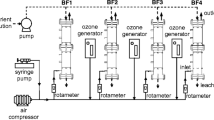Abstract
The Bacillus firmus was immobilized into Ca-alginate beads according to the different initial biomass concentration, calcification time and activation time. Three types of immobilized Bacillus firmus beads were packed respectively in trickling biofilter to purify xylene contained waste gases, and the performance of immobilized-cell biofilter was compared with traditional biofilm attached biofilter packed with two types of ceramic pellets. The results showed that three types of immobilized beads had different capabilities for removing xylene and life-spans. Higher initial biomass in immobilized beads resulted in better performance but shorter life-span. Activation process can remarkably enhance the activity of bacteria, and the removal efficiency of xylene can substantially be improved. Calcification time had influence on life-span of immobilized beads. Without acclimation, the cell-entrapped biofilter can obtain the maximum elimination capacity of 92.4 g/(m3·h). However, compared with biofilm attached biofilter, it has a poorer intrinsic drawback in volatile organic compounds (VOCs) removal due to the existence of excess mass transfer resistance.
Similar content being viewed by others
References
Elmrini H, Bredin N, Shareefdeen A, Heitz M. Biofiltration of xylene emissions: bioreactor response to variations in the pollutant inlet concentration and gas flow rate [J]. Chemical Engineering Journal, 2004, 100(1–3): 149–158.
Moretti E C. Practical Solutions for Reducing Volatile Organic Compounds and Hazardous Air Pollutants [M]. New York: Center for Waste Reduction Technologies of the American Institute of Chemical Engineers, 2001: 42–43.
Leson G, Winer A M. Biofiltration: an innovative air contamination control technology for VOC emission [J]. Journal of Air and Waste Management Association, 1991, 41(8): 1045–1054.
Van G J W, Hesselink P G M. Biotechniques for air pollution control [J]. Biodegradation, 1993, 4(4): 283–301.
Gribbins M J, Loehr R C. Effect of media nitrogen concentration on biofilter performance [J]. Journal of Air and Waste Management Association, 1998, 48(3): 216–226.
Wan N, Joon, S P, Jean S. Biofiltration of gasoline vapor by compost media [J]. Environmental Pollution, 2003, 121(2): 181–187.
Hartikainen T R, Vanhatalo M, Martikainen P J. Removal of ammonia from air by a peat biofilter [J]. Environment Technology, 1996, 17(1): 45–53.
Asano H, Myoga H, Asano M. A study of nitrification utilizing whole microorganisms immobilized by PVA-freezing methods [J]. Water Science and Technology, 1992, 26(5–6): 1037–1046.
Chung Y C, Huang C, Tseng C P. Operation optimization of Thiobacillus thioparus CH11 biofilter for hydrogen sulfide removal [J]. Journal of Biotechnology, 1996, 52(1): 31–38.
Chung Y C, Huang C. Biotreatment of ammonia in air by an immobilized Nitrosomonas eurpaea biofilter [J]. Environment Progress, 1998, 17(2): 70–76.
Chang C T, Chen B Y, Shiu I S, Jeng F T. Biofiltration of trimethylamine-containing waste gas by entrapped mixed microbial cells [J]. Chemosphere, 2004, 55(5): 751–756.
Chung Y C, Huang C, Tseng C P. Biotreatment of H2S-and NH3-containing waste gases by co-immobilized cells biofilter [J]. Chemosphere, 2000, 41(3): 329–336.
Mohd A I, Hiroyasu M, Yoshimasa Y. Removal of mixtures of acetaldehyde and propionaldehyde from waste gas in packed column with immobilized activated sludge gel beads [J]. Biochemical Engineering Journal, 2001, 8(1): 9–18.
Aksu Z, Bulbul G. Investigation of the combined effects of external mass transfer and biodegradation rates on phenol removal using immobilized P. putida in a packed-bed colunmn reactor [J]. Enzyme and Microbial Technology, 1998, 22(5): 397–403.
Buchanna R E, Gibbons N E. Bergey Manual of Determinative Bacteriology [M]. 8th ed. Baltimore: Williams and Wilkins, 1984.
Wang J L, Nigel H, Stentiford E, Yi Q. The radial distribution and bioactivity of Pseudomonas sp. immobilized in calcium alginate gel beads [J]. Process Biochemistry, 1999, 35(5): 465–469.
Park D H, Cha J M, Ryu H W, Lee G W, Yu E Y, Rhee J I, Park J J, Kim S W, Lee I W, Joe Y I, Ryu Y W, Hur B K, Park J K, Park K. Hydrogen sulfide removal utilizing immobilized Thiobacillus sp. IW with Ca-alginate bead [J]. Biochemical Engineering Journal, 2002, 11(2–3): 167–173.
Yun S I, Ohta Y. Removal of gaseous n-valeric acid in the air by Rhodococcus sp. B261 immobilized onto ceramic beads [J]. World Journal of Microbiology and Biotechnology, 1998, 14(3): 343–348.
Chung T P, Tseng H Y, Juang R S. Mass transfer effect and intermediate detection for phenol degradation in immobilized Pseudomonas putida systems [J]. Process Biochemistry, 2003, 38(10): 1497–1507.
Bandhyopadhyay K, Das D, Maiti B R. Solid matrix characterization of immobilized Pseudomonas putida MTCC 1194 used for phenol degradation [J]. Applied Microbiology and Biotechnology, 1999, 51(6): 891–895.
Author information
Authors and Affiliations
Corresponding author
Additional information
Project supported by the National Nature Science Foundation of China (Grant No.50608049), and the Shanghai Leading Academic Disciplines (Grant No.T105), and the Youth Development Foundation of Shanghai Municipal Commission of Education (Grant No.04AC107)
About this article
Cite this article
Liu, Q., Liu, Xj., Babajide, A.E. et al. Comparison of air-borne xylene biodegradation between immobilized-cell biofilter and biofilm attached biofilter. J. of Shanghai Univ. 11, 514–520 (2007). https://doi.org/10.1007/s11741-007-0515-3
Received:
Revised:
Issue Date:
DOI: https://doi.org/10.1007/s11741-007-0515-3




